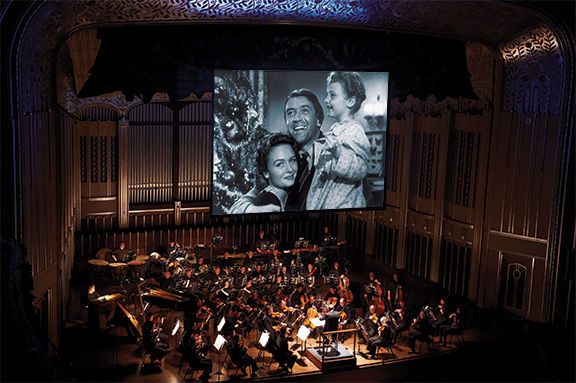From Hollywood productions to Northeast Ohio-made indie films, moviemaking on the ‘Third Coast’ is a growing industry and art form
By Bob Abelman
The “Third Coast.” That sure sounds better than “mistake on the lake.” Cleveland’s new and improved moniker comes courtesy of its recent emergence as a hub for international, regional and local movie making and exhibition.
And it’s not just Cleveland. There has been an onslaught of high-profile films hosted by Cincinnati, Cleveland and Columbus, including “Draft Day,” “Captain America: The Winter Soldier,” “The Ides of March,” “Carol” and “The Avengers.”
Those films and others have created more than 1,700 full-time equivalent jobs and generated more than $400 million in spending in Northeast Ohio in the past five years, according to a recent study conducted by the Maxine Goodman Levin College of Urban Affairs at Cleveland State University.
During the “Avengers” shoot, for example, locals were hired for location scouting, camera operation and loading, electrical and construction crews, as well as security, signage, catering and cleanup. Local actors have been cast as extras and in featured speaking and nonspeaking roles in such recent releases as “My Blind Brother,” “The Bronze,” “With This Ring” and “The Bye Bye Man.”
Much of the praise for this development goes to the Ohio film credit incentive program, created in 2009. The Ohio Development Services Agency offers refundable credits to film companies for up to a quarter of what they spend in the state and 35 percent for Ohio resident wages, with a cap set at $5 million per film and $20 million per year.
A consulting firm called Film Production Capital, which rates states by their film production incentives, gave Ohio three stars out of five, which puts the Buckeye State on par with other coastal states known for their moviemaking: New York and California.
Earning more stars are places like Louisiana (“Abraham Lincoln: Vampire Hunter,” “Green Lantern”), Georgia (“Lawless,” “The Blind Side”) and North Carolina (“Iron Man 3,” “Hunger Games”), where they offer even greater financial incentives. Because of this, according to Ivan Schwarz, president of the Greater Cleveland Film Commission, Cleveland lost “Ant-Man” and the next two “Avengers” movies to Atlanta, “even though Marvel Studios loves working here.”
While we may not yet be attracting as many film production companies as some other states, the Cleveland International Film Festival (CIFF) has no problem attracting independent films from around the globe and the people who love them.
The very first CIFF ran from April 13 through June 2, 1977, showing eight films from seven countries. They were seen by a handful of subscribers and their guests. Last year, the CIFF’s 39th, 193 feature films and 238 short films representing 60 countries were seen by 100,204 people over 11 days, making it a go-to destination for independent filmmakers and their fans.
Though the festival is truly international in scope, 32 films made by Ohioans were on display at CIFF39 in 2015, warranting their own “Local Heroes” category. This speaks volumes about the quality of the films being made locally in recent years.
One of those films, which received its world premiere at the CIFF, was “On a Technicality” – a short film (22 minutes) made on a small budget ($21,000) and shot in three days, though the editing took more than 100 hours. Written by local actor Jeff Grover, who was featured in and co-produced the film, it was directed by Andrew Gorell and co-produced by Steven Hacker, who was also the film’s cinematographer.
Their positive CIFF experience and that of Cleveland cast members George Roth, Brian Zoldessy, Scott Miller and Joel Hammer reflect well on the burgeoning cottage industry that is local filmmaking. So does the journey “On a Technicality” took afterward.
The entirety of “On a Technicality” takes place in the back booth at Jack’s Deli on Cleveland’s East Side, where five old friends examine the value of friendship during a troubling time – the illness and subsequent death of one of their own – over a series of brunches. Days before the film’s debut, the actors – actually old friends – sat down to chat about the film and did so with the same witty banter that saturates their characters’ exchanges.
“Clearly, the moviemaking scene in Northeast Ohio is thinking globally but acting locally.”
Canvas: What is it about eating that filmmakers find so intriguing and revealing? It plays such a central role in films like “Chef” (2014), “Waitress” (2007), “Ratatouille” (2007), “Babette’s Feast” (1987), “My Dinner With Andre” (1981) and so many others.
Roth: There is something so communal about eating, particularly at a deli. Audiences will automatically find the setting of our film comfortable and the shorthand that we speak between and during mouthfuls to be immediately recognizable.
Grover: Also, what people choose to eat and how they eat communicates so much about a person. For filmmakers, one bite is worth a thousand words.
Canvas: While having actors confined to a booth is probably a dream for directors (easy to capture on camera) and costumers (no need for pants), does it create any particular creative challenges for you?
Miller: For the record, I believe all of us were wearing pants. Maybe not Joel.
Roth: The seating actually helped inform the relationships between these five guys. We developed a more intimate relationship with the fellows sitting next to us, which comes across in the film and makes the friendships seem more realistic.
Zoldessy: With so little movement, the focus is on what we say and the emotional connection between us.
Miller: And it was nice to know that, no matter what, I was always hitting my mark.
Grover: Joel lucked out by being seated in the middle of the booth. We wouldn’t let him out for bathroom breaks which, I think, added some interesting texture to his performance.
Hammer: I’m normally an aisle seat kind of guy. In case of fire.
Canvas: How does being friends in life inform your portrayal of friends on film?
Roth: We’re playing characters, but because our real-life relationships were established before this film began, our reactions to each other’s scripted dialogue are very authentic.
Hammer: Plus we did not have a lot of time to work on this, so being friends allowed us to be authentic without needing a lot of rehearsal.
Grover: Although we haven’t known each other since grade school, as have our characters, we still have a chemistry and sense of fun that were captured on camera. Both of those qualities proved to be essential for the story we are telling, particularly when illness intrudes on the inner circle of these five old friends.
Canvas: What do you hope to be the audience’s take-away from this film?
Miller: This film is about friendship. It’s about sticking it out, being there for each other, supporting each other, belonging. Friendships are families of choice. I hope this movie reminds people to treasure those they have chosen to include in their inner circle.
Zoldessy: Yes. Family is broader than blood.
Grover: I hope that the audience will be able to imagine the “what ifs” in life and know that good friends will always have their back.
They did.
The film was very well received at the CIFF and, bolstered by its success and notoriety, went on to several other festivals, including the New York Independent Film Festival, Cincinnati Film Festival, Kansas City Jewish Film Festival, and NST/SFF on Long Island. Grover and his colleagues are also considering web-based options to make the film easily accessible to others, including Video on Demand, Amazon and VIMEO. Also underway is “On a Technicality II,” a working title, with the same collaborators under the auspices of a new production company, g2h films. There are three other projects in production as well.
Clearly, the moviemaking scene in Northeast Ohio is thinking globally but acting locally. Additional proof came June 29, when Ohio Governor John Kasich has signed into law a revised Ohio Motion Picture Tax Credit, passed in May by the Ohio General Assembly. The move raises the annual incentive cap to $40 million, removes the $5 million per project cap, and changes the incentive rate to a flat 30 percent on all production dollars spent in Ohio.
Translation: More incentive for Hollywood to come to Northeast Ohio, and more reason to believe Cleveland may be bumped up in status to the “Second Coast.” CV
Photos in lead image from left to right: Brian Zoldessy, Scott Miller, Joel Hammer, George Roth and Jeffrey Grover in a scene from “On a Technicality”; Jeffrey Grover as “Howard” preparing for a take for “On a Technicality”; and George Roth as “Bruce” in “On a Technicality.” Photos courtesy of g2h films; illustration by Jon Larson.











